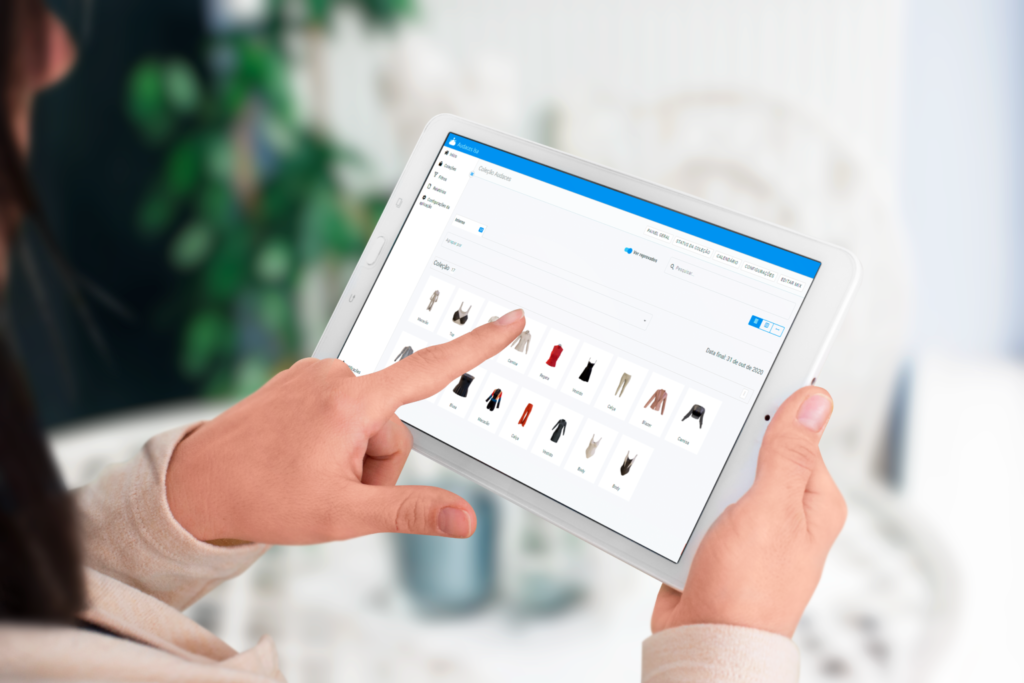Summary
- Clothing management encompasses all the processes and operations involved in launching apparel collections.
- Proper planning is essential to ensure efficient production and successful sales, reducing costs and maximizing profits.
- Technology can assist you from the beginning to the end of the planning process. Try Audaces360 solutions for free!
Clothing management should be your focus, whether you’re a brand or a manufacturer that produces for other companies.
The idea of rushing into production as soon as possible may seem tempting. However, without proper planning, delays and waste are highly likely to happen.
In this comprehensive guide, we’ll teach you 4 effective strategies for implementing successful clothing management right away.
Enjoy your reading!
Sumário
Why is clothing management important for your fashion business?
Understanding all processes involved in your collection is crucial to prevent issues. Knowing how each step operates streamlines workflows and helps identify potential bottlenecks.
Mapping out the entire process from start to finish also facilitates monitoring. This translates to increased efficiency and agility in delivering results from each area.
Consistency in planning is the path to achieving product quality. Consequently, it contributes to higher customer satisfaction and reduces the risk of returns and complaints.
For manufacturers, clothing management allows for negotiating better deals with suppliers and optimizing production costs.
Learn more: 6 benefits of having an online collection management

What is clothing management?
Clothing management refers to coordinating the entire lifecycle of apparel design or production. It’s overseeing all the processes involved, from the initial idea to the finished product.
This comprehensive approach ensures efficiency, cost-effectiveness, and sustainable practices within the clothing industry.
Technology is a powerful ally in this planning process. It ranges from simple tools to complete solutions that provide a real-time view of entire projects.
What are the core strategies for successful clothing management?
Effective clothing management guides you on where to focus your energy. These 4 key areas are a great starting point for your planning:
1) Collection planning
This process is about the strategic steps of developing and launching a new clothing collection.
For brands, it includes activities such as trend research, concept development, product design, and material selection.
When it comes to manufacturers, the process involves negotiation with suppliers, material procurement, production planning, and batch tracking.
Effective collection planning ensures that the right products go to market at the right time.
Learn more: 7 steps to develop your fashion collection plan
2) Inventory control
Apparel manufacturing companies need to constantly oversee several important aspects related to inventory.
They include stock levels of raw materials, work-in-progress items, and finished garments throughout the supply chain.
Successful inventory control aims to minimize stock outs, prevent overstocking, and optimize storage costs while ensuring adequate availability to meet customer demand.
Learn more: Discover 8 best practices for optimizing apparel inventory management
3) Logistics and distribution
This key step ensures that customers receive their orders within the estimated timeframe.
Timely delivery is a critical aspect of clothing management. We all know how waiting for an item that arrives late or incorrect can be very frustrating. This can lead to returns and a negative customer experience
For brands, such delays can cause a stain on their reputation. For manufacturers, it can translate to the loss of important business opportunities.
Logistics and distribution encompass the movement of goods from factories and warehouses to retail stores or customers.
Activities such as transportation planning, order fulfillment, shipment tracking, and returns management are part of the routine.
4) Quality management

This is the point of clothing management that establishes and maintains quality standards throughout the development or production process.
It includes activities such as raw material inspection, product testing, quality control checks, and defect management. Creation and production must work together to guarantee the result matches the initial design.
Good quality management ensures that products meet the desired standards for functionality, durability, and appearance. It helps to enhance customer satisfaction and brand reputation.
Benefits of effective clothing management for your business
Now you understand the importance of clothing management and how to implement it in practice.
However, what are the specific benefits you can expect to see in your business?
Here are some of the key outcomes you should strive for and measure to track your progress.
Enhanced performance efficiency
A well-structured clothing management system streamlines processes, eliminates redundancies, and optimizes resource allocation.
This translates to faster order fulfillment, reduced lead times, and improved inventory control.
Remember: when it comes to fashion, timing is everything. Efficient workflows ensure timely product launches, maximizing sales opportunities.
Seamless communication between areas
A focused look in clothing management fosters open communication and collaboration among different areas, such as design, development, production, sales, and logistics.
This breaks down silos, ensures alignment on goals, and enables timely problem-solving.
Furthermore, bringing together different fields stimulates the exchange of ideas. This merging of perspectives from diverse areas enriches the creation of more innovative products.
Using digital tools can further enhance communication. Explore software that allows you to customize the interface. This way you can tailor the solution according to your processes.
Ideally, all stakeholders should have real-time access, enabling everyone to see changes as they happen. It’s a plus if teams can communicate through the tool, centralizing all information in one place.
Learn more: How to select pieces of clothing for a successful fashion collection?
Reduced rework costs
By minimizing errors throughout the clothing management process, businesses can significantly reduce the costs associated with rework.
This includes expenses related to the making of multiple garment samples, for example. Effective planning and the right tools will help you design with more assertiveness.
Additional rework costs to consider when calculating prices include replacing defective items and handling customer returns. With good planning, you can easily eliminate these issues.
Which technologies can streamline clothing management?

The fashion industry is constantly evolving, and technology plays a major role in streamlining operations and enhancing efficiency.
A diverse range of digital solutions can address various challenges and optimize your clothing management.
Here are the main ones:
CAD software
CAD software streamlines clothing management by optimizing the design of new items.
It allows users to create, edit, and manipulate designs digitally. It provides a digital environment like traditional drafting tools but with greater flexibility.
These solutions range from simple 2D drafting programs to complex 3D modeling applications. Ultimately, it offers various tools and features to support different design tasks.
Fashion designers can create intricate patterns, sketches, and technical drawings with precise detail.
Unlike physical drawings, CAD software allows for easy changes and adjustments. It leads to the exploration of different ideas and more precise results.
Learn more: What is CAD software and why use it to produce fashion?
Artificial Intelligence
Artificial intelligence can streamline clothing management in various ways, mainly through the development of creative designs.
With AI, designers can explore a multitude of options in a short time. All of this is because it can generate several ideas automatically. It means experimenting more, finding inspiration, and discovering new trends with maximum efficiency.
Moreover, AI can help designers simplify the creative process by providing helpful suggestions and insights.
AI can use smart algorithms to analyze fashion data and trends, providing advice on colors and styles. It helps to ease decision-making and create garments aligned with market demands.
Learn more: How to use Artificial Intelligence design in your fashion creation
PLM and ERP systems
Among all the solutions, these are definitely the most essential for clothing management, especially PLM (Product Lifecycle Management).
It covers every stage of bringing a product to life, including design, development, sample creation, approvals, and adjustments.
It allows a complete view of the collection and real-time monitoring. Moreover, PLM enables companies to enhance collaboration among different teams. This approach stimulates information sharing and tracking the progress of each project.
Meanwhile, ERP (Enterprise Resource Planning) is an integrated system that allows businesses to manage and automate processes. It allows an overview of areas like accounting, finances, human resources, purchasing, sales, production, and logistics.
ERP integrates data and processes of the entire business, reducing errors and enhancing performance.
Learn more: How can your apparel business integrate PLM and ERP?
Optimize your clothing management with Audaces Isa Fashion PLM

Streamline your workflow, accelerate production, and elevate your brand with Audaces Isa!
This innovative solution empowers fashion companies to take control of their entire collection development process. From initial ideas to final products.
Audaces Isa centralizes data and fosters collaboration, leading to more than a 30% reduction in product launch time. Deliver collections to market with greater agility!
You can even have real-time access to your collection’s progress directly from your phone, with the mobile version. Identify potential issues early, track progress seamlessly, and enable teams to optimize production and quality.
Additionally, generate dynamic reports that provide actionable insights. Analyze trends, find areas for improvement, and make informed decisions that drive success for your collections.
Keep leveraging the power of expert content! Download our free interactive dashboard and eliminate delays in your fashion collections.
FAQ
Understanding all processes involved in your collection is crucial to prevent issues. Knowing how each step operates streamlines workflows and helps identify potential bottlenecks.
Clothing management refers to coordinating the entire lifecycle of apparel design or production. It’s overseeing all the processes involved from the initial idea to the finished product.
Collection planning, inventory control, logistics and distribution, and quality management.










